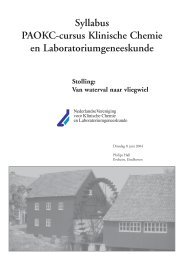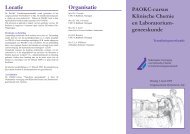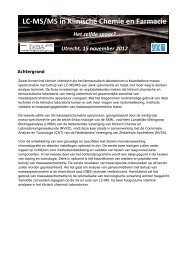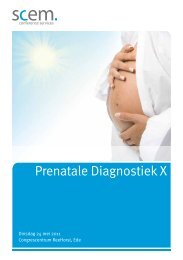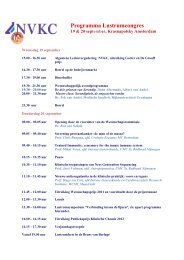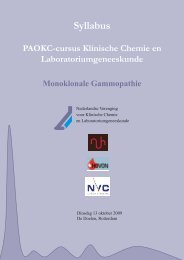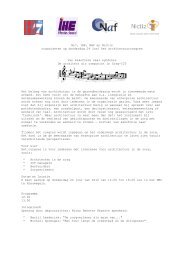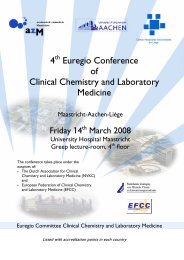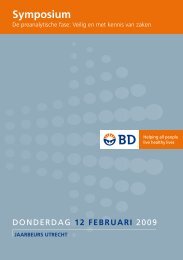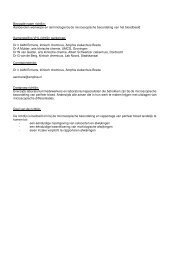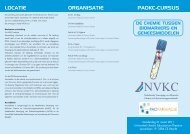SKML-Quality Mark for point-of-care test (POCT) glucose ... - NVKC
SKML-Quality Mark for point-of-care test (POCT) glucose ... - NVKC
SKML-Quality Mark for point-of-care test (POCT) glucose ... - NVKC
You also want an ePaper? Increase the reach of your titles
YUMPU automatically turns print PDFs into web optimized ePapers that Google loves.
Article in press - uncorrected pro<strong>of</strong><br />
1022 Jansen and Slingerland: <strong>SKML</strong>-<strong>Quality</strong> <strong>Mark</strong> <strong>for</strong> <strong>POCT</strong> <strong>glucose</strong> meters<br />
ment has been studied extensively (7–10). For medical <strong>test</strong>s<br />
in general, there is consensus about the analytical requirements<br />
in relation to diagnostic utility and clinical usefulness.<br />
These requirements are based on the biological variation concept<br />
as described by Fraser (11, 12). Data on biological variation<br />
and analytical requirements derived from this were<br />
compiled by Ricos et al. (13) and Westgard (14) in a database<br />
<strong>for</strong> a large number <strong>of</strong> clinical laboratory <strong>test</strong>s. However, neither<br />
the IVD directive or the ISO or TNO guidelines mention<br />
these requirements.<br />
In this article, a (External <strong>Quality</strong> Assessment Scheme)<br />
<strong>SKML</strong>-<strong>Quality</strong> <strong>Mark</strong> <strong>for</strong> <strong>POCT</strong> and self-<strong>test</strong> <strong>glucose</strong> meters<br />
is proposed, assessing analytical quality and technical quality.<br />
The analytical requirements are based on the biological<br />
variation concept, and a system to assess meters <strong>for</strong> the<br />
<strong>SKML</strong>-<strong>Quality</strong> <strong>Mark</strong> is described. Using the proposed system<br />
as an example, 14 meters were <strong>test</strong>ed.<br />
Materials and methods<br />
The quality <strong>of</strong> a <strong>glucose</strong> measurement using a <strong>POCT</strong> or self-<strong>test</strong><br />
meter depends on the quality <strong>of</strong> the equipment, the quality <strong>of</strong> how<br />
it is used, and the pre-analytical conditions. The <strong>SKML</strong>-<strong>Quality</strong><br />
<strong>Mark</strong> assesses the quality <strong>of</strong> the equipment on two aspects: analytical<br />
quality based on the biological variation concept, and technical<br />
quality based on the ISO 15197 and the TNO guideline.<br />
Analytical quality<br />
To assess the analytical quality <strong>of</strong> the equipment in relation to the<br />
diagnostic utility and clinical usefulness, the analytical goal is based<br />
on the biological variation concept. The analytical quality <strong>of</strong> the<br />
<strong>POCT</strong> and self-<strong>test</strong> equipment is assessed using plasma calibrated<br />
<strong>glucose</strong> values compared with a trueness verified method traceable<br />
to the IFCC reference method in an accredited clinical laboratory.<br />
In this investigation, the hexokinase method using the Roche Integra<br />
(Nederland BV, Almere, The Netherlands) with plasma obtained<br />
from centrifuged heparinized whole blood was used. To correct <strong>for</strong><br />
any bias in the hexokinase method on a specific day <strong>of</strong> <strong>test</strong>ing,<br />
commutable and IFCC reference method targeted <strong>SKML</strong> Calibration<br />
2000 samples (15, 16) were also measured. During the study period,<br />
no bias from the reference materials was observed.<br />
The analytical quality <strong>of</strong> 14 different types <strong>of</strong> meters was <strong>test</strong>ed<br />
type by type. Five meters <strong>of</strong> each type were evaluated.<br />
To assess the quality <strong>of</strong> one type <strong>of</strong> <strong>glucose</strong> <strong>POCT</strong> or home-use<br />
meter, three 6 mL heparinized venous blood samples (without separator<br />
gel) were obtained from an apparently healthy person, who<br />
was not taking any medication. An aliquot <strong>of</strong> 0.5 mL was removed<br />
through the cap <strong>of</strong> a tube, centrifuged and analysed <strong>for</strong> <strong>glucose</strong><br />
using the comparison method. Using a needle, an aliquot (1 mL <strong>for</strong><br />
6 and <strong>of</strong> 2 mL <strong>for</strong> 10 mmol/L) <strong>of</strong> a 45% <strong>glucose</strong> solution in water<br />
was added through the caps <strong>of</strong> two <strong>of</strong> the tubes to produce <strong>glucose</strong><br />
concentrations <strong>of</strong> approximately 6 mmol/L and 10 mmol/L, respectively.<br />
The third tube was maintained until the <strong>glucose</strong> concentration<br />
was about 3 mmol/L. Aliquots <strong>of</strong> 0.5 mL were removed though the<br />
caps <strong>of</strong> the three tubes, centrifuged and analysed <strong>for</strong> <strong>glucose</strong> using<br />
the comparison method 10 times each. Immediately following the<br />
completion <strong>of</strong> centrifugation, measurements using the comparison<br />
method and the <strong>glucose</strong> meters were started. The measurements<br />
were per<strong>for</strong>med within 120 s <strong>for</strong> the 25 measurements at each concentration,<br />
and within 240 s <strong>for</strong> the 50 measurements <strong>for</strong> estimation<br />
<strong>of</strong> imprecision. In addition, pO 2 was measured in the three tubes<br />
<strong>for</strong> meters using the <strong>glucose</strong> oxidase method. For <strong>glucose</strong> meters<br />
using this method, the partial pressure <strong>of</strong> oxygen in the sample is<br />
required that is comparable to the pO 2 in capillary blood. There<strong>for</strong>e,<br />
tubes were mixed prior to the procedures until the pO 2 was within<br />
8.0 and 12.0 kPa. Whole blood <strong>glucose</strong> measurements were per<strong>for</strong>med<br />
by sampling blood through the caps <strong>of</strong> the tubes and applied<br />
to the five meters we investigated that used this method in each<br />
session.<br />
The imprecision <strong>of</strong> the handheld equipment was estimated at a<br />
<strong>glucose</strong> concentration <strong>of</strong> 6 mmol/L using 50 measurements, 10 on<br />
each <strong>of</strong> the five meters that were <strong>test</strong>ed per type <strong>of</strong> meter (total 50<br />
measurements per type <strong>of</strong> meter) using two different lots <strong>of</strong> <strong>test</strong><br />
strips. The bias <strong>of</strong> the handheld equipment was estimated from 75<br />
measurements, five measurements at each <strong>of</strong> three concentrations,<br />
on each <strong>of</strong> the five meters. Total error was also estimated from the<br />
basis <strong>of</strong> the combined 75 measurements.<br />
Linearity was assessed using three concentrations <strong>of</strong> 3, 6 and<br />
10 mmol/L, according to the Passing and Bablok regression.<br />
Interference from acetaminophen was assessed by splitting freshly<br />
drawn heparinized venous blood into two 1 mL aliquots, adding<br />
1 mL <strong>of</strong> a concentrated solution (66 mmol/L) <strong>of</strong> the substance to a<br />
final concentration <strong>of</strong> 66 mmol/L, and the same amount <strong>of</strong> saline<br />
(154 mmol/L) to the second aliquot. Glucose was measured in each<br />
<strong>of</strong> the aliquots using five meters. From each <strong>of</strong> the aliquots, 0.5 mL<br />
was centrifuged and plasma <strong>glucose</strong> was measured five times using<br />
the trueness-verified Roche Integra hexokinase method.<br />
Interference from ascorbic acid was assessed in essentially the<br />
same way (using a concentrated solution <strong>of</strong> 170 mmol/L ascorbic<br />
acid) at a final concentration <strong>of</strong> 170 mmol/L.<br />
The effect <strong>of</strong> haematocrit was assessed by measuring the haematocrit<br />
in three heparinized venous blood samples having <strong>glucose</strong><br />
concentrations <strong>of</strong> approximately 3, 6 and 10 mmol/L. Each sample<br />
was centrifuged, and <strong>for</strong> each <strong>glucose</strong> concentration, four portions<br />
were prepared with haematocrit values <strong>of</strong> approximately 0.25, 0.35,<br />
0.45 and 0.55. The haematocrit was measured using a Sysmex 2500<br />
analyzer (Sysmex Nederland BV, Etten-Leur, The Netherlands).<br />
Glucose in each portion (with the pO 2 between 8.0 and 12.0 kPa)<br />
was measured in duplicate on two meters and in the plasma obtained<br />
after centrifugation using the hexokinase method.<br />
Statistical methods<br />
We used the known within- and between-person variation. For <strong>glucose</strong>,<br />
the within-person variation, CVw, is 5.7% and the betweenperson<br />
variation, CVb, is 6.9%. From these the allowable bias (AB)<br />
is calculated as<br />
2 2<br />
ABs0.25=6(CVw qCVb )s2.23%.<br />
The desirable analytical variation<br />
CVds0.5=CVws2.9%<br />
and the total allowable error (TAE)<br />
TAEsABq(1.65=CVd)s7.0%.<br />
However, with these calculations a definitive known target value<br />
is assumed. In the present study, there is an uncertainty component<br />
in the estimation <strong>of</strong> the target value. This uncertainty is accounted<br />
<strong>for</strong> under the next section ‘uncertainty in target value <strong>of</strong> the trueness<br />
verified method’.



